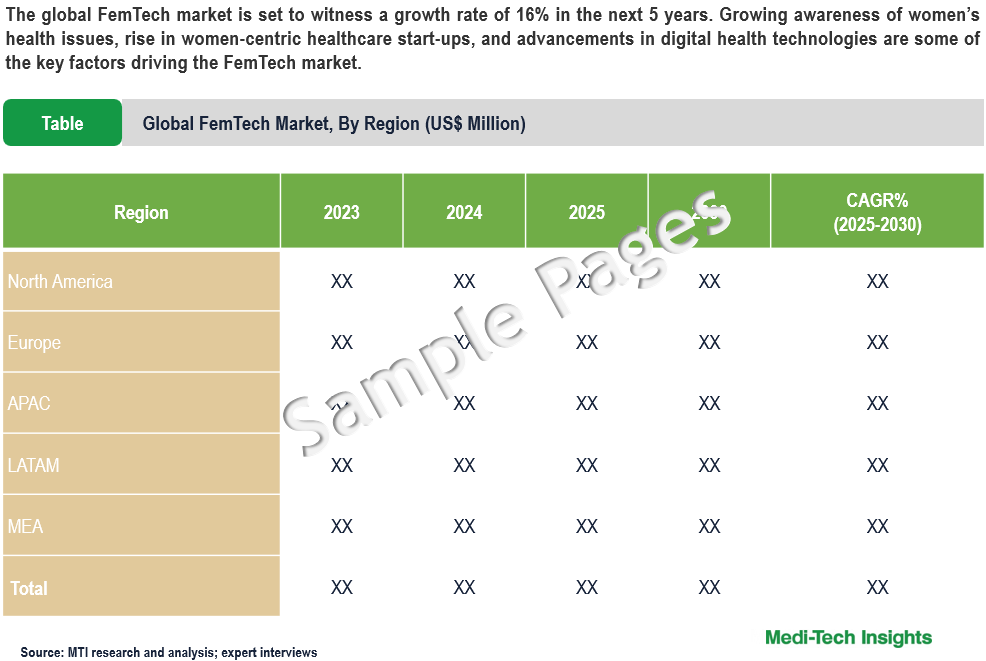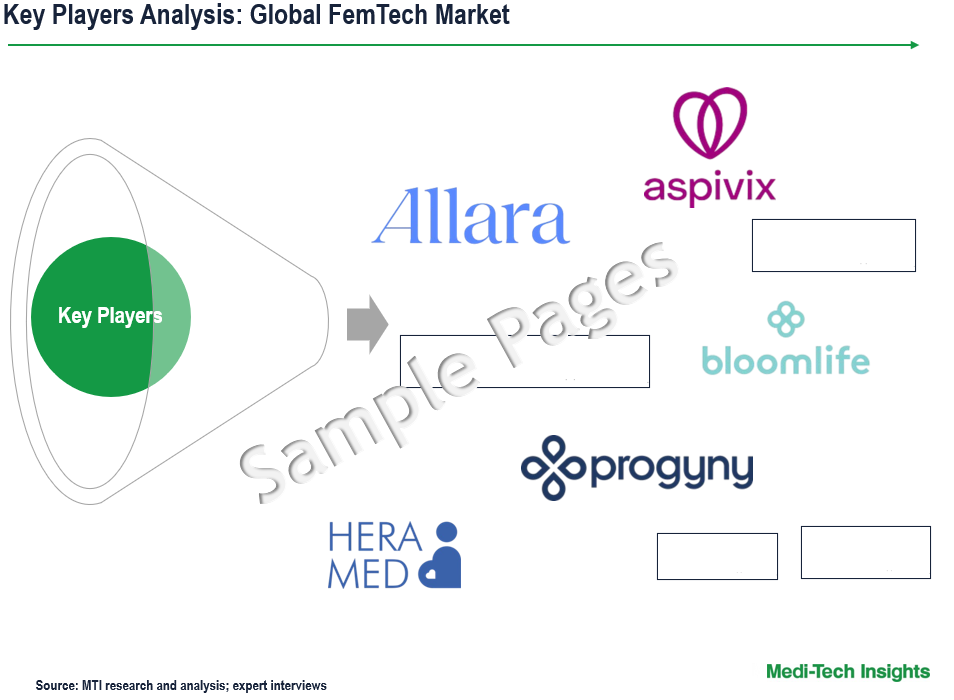
FemTech Market Report Segmented by Offering (Software, Services, Devices, Consumer Products), Application (Menstrual Health & Period Tracking, Fertility & Ovulation), Buyer Type (Consumers, Providers, Employers, Payers) Forecast to 2030
The global FemTech market is set to witness a growth rate of 16% in the next 5 years. Growing awareness of women’s health issues, rise in women-centric healthcare start-ups, advancements in digital health technologies, rising demand for personalized healthcare solutions, growing prevalence of chronic and reproductive health issues, supportive government initiatives & policies, and rising demand for telemedicine & remote healthcare are some of the key factors driving the FemTech market. To learn more about the research report, download a sample report.
Report Overview
FemTech, short for Female Technology, refers to a category of technology-driven products, software, and services designed to address women's health needs. This includes areas such as reproductive health, fertility tracking, maternal care, menstrual health, menopause management, and gynecological disorders among others. Additionally, FemTech encompasses digital health solutions like mobile apps, wearable devices, telemedicine, and AI-driven diagnostics tailored for women’s well-being. The market is driven by increasing awareness, advancements in healthcare technology, and growing investments in women's health. As the sector expands, it plays a crucial role in bridging healthcare gaps and promoting personalized, accessible, and data-driven solutions for women worldwide.
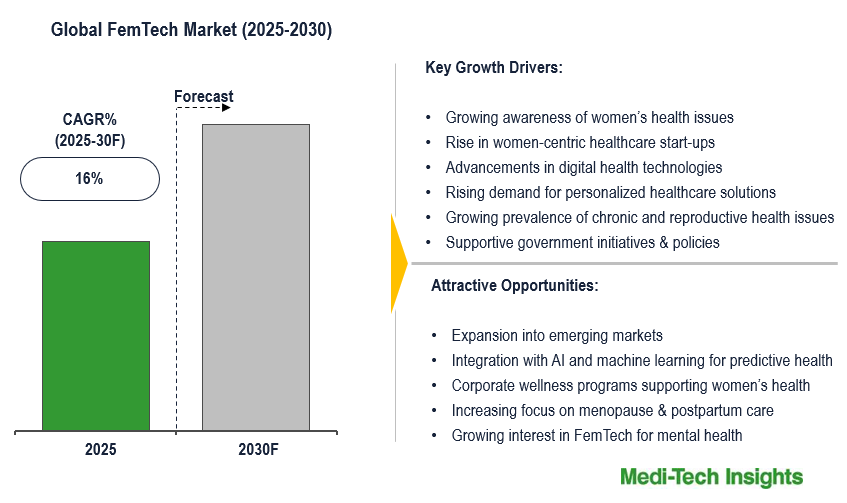
To learn more about this report, download the PDF brochure
Growing awareness of women’s health issues to propel market demand
Growing awareness of women’s health issues is a major driver of the FemTech market, as more women seek solutions for menstrual health, fertility, pregnancy, menopause, and overall wellness. Increased education, social media advocacy, and destigmatization efforts have empowered women to prioritize their health. This has led to a surge in demand for digital tools, wearables, and telemedicine platforms that offer personalized healthcare management. Governments and organizations are also investing in women’s health initiatives, further fueling the adoption of FemTech solutions. As awareness continues to rise, the market is expected to expand, driving innovation and accessibility in women’s healthcare.
Advancements in digital health technologies is driving the market growth
Advancements in digital health technologies are transforming the FemTech market by enabling more accurate, data-driven, and personalized healthcare solutions for women. Innovations in AI, IoT, Big Data, and wearable technology have led to smart menstrual trackers, AI-powered fertility apps, and real-time hormone monitoring. These technologies provide predictive insights, remote diagnostics, and personalized health recommendations, improving women’s access to quality care. Wearable devices for ovulation tracking, pregnancy monitoring, and menopause symptom management are becoming mainstream. As digital health continues to evolve, the integration of advanced analytics and telemedicine is further expanding the reach and effectiveness of FemTech solutions.
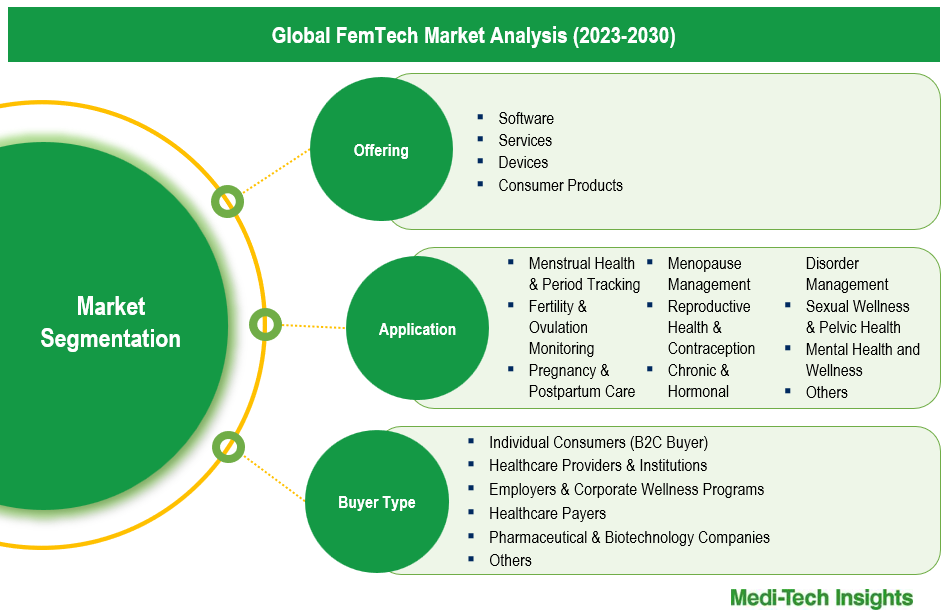
To learn more about this report, download the PDF brochure
Competitive Landscape Analysis
The global FemTech market is marked by the presence of established and emerging market players such as Allara Health, Aspivix SA, Bloomlife, Chiaro Technology Ltd., Flo Health Inc., HeraMED, Natural Cycles USA Corp, NUVO Inc., Progyny, Inc., and Pulsenmore Ltd.; among others. Some of the key strategies adopted by market players include new product development, strategic partnerships and collaborations, and geographic expansion.
Report Scope
| Report Metric | Details |
| Base Year Considered | 2024 |
| Historical Data | 2023 - 2024 |
| Forecast Period | 2025 - 2030 |
| Growth Rate | 16% |
| Market Drivers |
|
| Attractive Opportunities |
|
| Segment Scope | Offering, Application, Buyer Type |
| Regional Scope |
|
| Key Companies Mapped | Allara Health, Aspivix SA, Bloomlife, Chiaro Technology Ltd., Flo Health Inc., HeraMED, Natural Cycles USA Corp, NUVO Inc., Progyny, Inc., and Pulsenmore Ltd. |
| Report Highlights | Market Size & Forecast, Growth Drivers & Restraints, Trends, Competitive Analysis |
Global FemTech Market Segmentation
This report by Medi-Tech Insights provides the size of the global FemTech market at the regional- and country-level from 2023 to 2030. The report further segments the market based on offering, application, buyer type.
Market Size & Forecast (2023-2030), By Offering, USD Million
- Software
- Services
- Devices
- Consumer Products
Market Size & Forecast (2023-2030), By Application, USD Million
- Menstrual Health & Period Tracking
- Fertility & Ovulation Monitoring
- Pregnancy & Postpartum Care
- Menopause Management
- Reproductive Health & Contraception
- Chronic & Hormonal Disorder Management
- Sexual Wellness & Pelvic Health
- Mental Health and Wellness
- Others
Market Size & Forecast (2023-2030), By Buyer Type, USD Million
- Individual Consumers (B2C Buyer)
- Healthcare Providers & Institutions
- Employers & Corporate Wellness Programs
- Healthcare Payers
- Pharmaceutical & Biotechnology Companies
- Others
Market Size & Forecast (2023-2030), By Region, USD Million
- North America
- US
- Canada
- Europe
- UK
- Germany
- France
- Italy
- Spain
- Rest of Europe
- Asia Pacific
- China
- India
- Japan
- Rest of Asia Pacific
- Latin America
- Middle East & Africa
Key Strategic Questions Addressed
- What is the market size & forecast of the FemTech market?
- What are historical, present, and forecasted market shares and growth rates of various segments and sub-segments of the FemTech market?
- What are the key trends defining the market?
- What are the major factors impacting the market?
- What are the opportunities prevailing in the market?
- Which region has the highest share in the global market? Which region is expected to witness the highest growth rate in the next 5 years?
- Who are the major players operating in the market?
- What are the key strategies adopted by players?
- Introduction
- Introduction
- Market Scope
- Market Definition
- Segments Covered
- Regional Segmentation
- Research Timeframe
- Currency Considered
- Study Limitations
- Stakeholders
- List of Abbreviations
- Key Conferences and Events (2025-2026)
- Research Methodology
- Secondary Research
- Primary Research
- Market Estimation
- Bottom-Up Approach
- Top-Down Approach
- Market Forecasting
- Executive Summary
- FemTech Market Snapshot (2025-2030)
- Segment Overview
- Regional Snapshot
- Competitive Insights
- Market Overview
- Market Dynamics
- Drivers
- Growing awareness of women’s health issues
- Rise in women-centric healthcare start-ups
- Advancements in digital health technologies
- Rising demand for personalized healthcare solutions
- Growing prevalence of chronic and reproductive health issues
- Supportive government initiatives & policies
- Rising demand for telemedicine & remote healthcare
- Restraints
- Regulatory and compliance challenges
- Data privacy & security concerns
- Limited insurance coverage for FemTech solutions
- High cost of advanced FemTech solutions
- Opportunities
- Expansion into emerging markets
- Integration with AI and machine learning for predictive health
- Corporate wellness programs supporting women’s health
- Increasing focus on menopause & postpartum care
- Growing interest in FemTech for mental health
- Key Market Trends
- Increasing partnerships with healthcare providers & pharmaceuticals
- Growth of direct-to-consumer (DTC) models
- Rise of wearable technology
- Unmet Market Needs
- Industry Speaks
- Drivers
- Market Dynamics
- Global FemTech Market Size & Forecast (2023-2030), By Offering, USD Million
- Introduction
- Software
- Services
- Devices
- Consumer Products
- Global FemTech Market Size & Forecast (2023-2030), By Application, USD Million
- Introduction
- Menstrual Health & Period Tracking
- Fertility & Ovulation Monitoring
- Pregnancy & Postpartum Care
- Menopause Management
- Reproductive Health & Contraception
- Chronic & Hormonal Disorder Management
- Sexual Wellness & Pelvic Health
- Mental Health and Wellness
- Others
- Global FemTech Market Size & Forecast (2023-2030), By Buyer Type, USD Million
- Introduction
- Individual Consumers (B2C Buyer)
- Healthcare Providers & Institutions
- Employers & Corporate Wellness Programs
- Healthcare Payers
- Pharmaceutical & Biotechnology Companies
- Others
- Global FemTech Market Size & Forecast (2023-2030), By Region, USD Million
- Introduction
- North America FemTech Market Size & Forecast (2023-2030), By Country, USD Million
- US
- Market Size & Forecast, By Offering (USD Million)
- Market Size & Forecast, By Application (USD Million)
- Market Size & Forecast, By Buyer Type (USD Million)
- Canada
- Market Size & Forecast, By Offering (USD Million)
- Market Size & Forecast, By Application (USD Million)
- Market Size & Forecast, By Buyer Type (USD Million)
- US
- Europe FemTech Market Size & Forecast (2023-2030), By Country, USD Million
- UK
- Market Size & Forecast, By Offering (USD Million)
- Market Size & Forecast, By Application (USD Million)
- Market Size & Forecast, By Buyer Type (USD Million)
- Germany
- Market Size & Forecast, By Offering (USD Million)
- Market Size & Forecast, By Application (USD Million)
- Market Size & Forecast, By Buyer Type (USD Million)
- France
- Market Size & Forecast, By Offering (USD Million)
- Market Size & Forecast, By Application (USD Million)
- Market Size & Forecast, By Buyer Type (USD Million)
- Italy
- Market Size & Forecast, By Offering (USD Million)
- Market Size & Forecast, By Application (USD Million)
- Market Size & Forecast, By Buyer Type (USD Million)
- Spain
- Market Size & Forecast, By Offering (USD Million)
- Market Size & Forecast, By Application (USD Million)
- Market Size & Forecast, By Buyer Type (USD Million)
- Rest of Europe
- Market Size & Forecast, By Offering (USD Million)
- Market Size & Forecast, By Application (USD Million)
- Market Size & Forecast, By Buyer Type (USD Million)
- UK
- Asia Pacific (APAC) FemTech Market Size & Forecast (2023-2030), By Country, USD Million
- China
- Market Size & Forecast, By Offering (USD Million)
- Market Size & Forecast, By Application (USD Million)
- Market Size & Forecast, By Buyer Type (USD Million)
- Japan
- Market Size & Forecast, By Offering (USD Million)
- Market Size & Forecast, By Application (USD Million)
- Market Size & Forecast, By Buyer Type (USD Million)
- India
- Market Size & Forecast, By Offering (USD Million)
- Market Size & Forecast, By Application (USD Million)
- Market Size & Forecast, By Buyer Type (USD Million)
- Rest of Asia Pacific
- Market Size & Forecast, By Offering (USD Million)
- Market Size & Forecast, By Application (USD Million)
- Market Size & Forecast, By Buyer Type (USD Million)
- China
- Latin America (LATAM) FemTech Market Size & Forecast (2023-2030), USD Million
- Market Size & Forecast, By Offering (USD Million)
- Market Size & Forecast, By Application (USD Million)
- Market Size & Forecast, By Buyer Type (USD Million)
- Middle East & Africa (MEA) FemTech Market Size & Forecast (2023-2030), USD Million
- Market Size & Forecast, By Offering (USD Million)
- Market Size & Forecast, By Application (USD Million)
- Market Size & Forecast, By Buyer Type (USD Million)
- Competitive Landscape
- Key Players and their Competitive Positioning
- Key Player Comparison
- Segment-wise Player Mapping
- Market Share Analysis (2024)
- Company Categorization Matrix
- Dominants/Leaders
- New Entrants
- Emerging Players
- Innovative Players
- Key Strategies Assessment, By Player (2022-2025)
- New Product and Service Launches
- Partnerships, Agreements, & Collaborations
- Mergers & Acquisitions
- Geographic Expansion
- Key Players and their Competitive Positioning
- Company Profiles*
(Business Overview, Financial Performance**, Products Offered, Recent Developments)
- Allara Health
- Aspivix SA
- Bloomlife
- Chiaro Technology Ltd.
- Flo Health Inc.
- HeraMED
- Natural Cycles USA Corp
- NUVO Inc.
- Progyny, Inc.
- Pulsenmore Ltd.
- Other Prominent Players
Note: *Indicative list
**For listed companies
The study has been compiled based on extensive primary and secondary research.
Secondary Research (Indicative List)
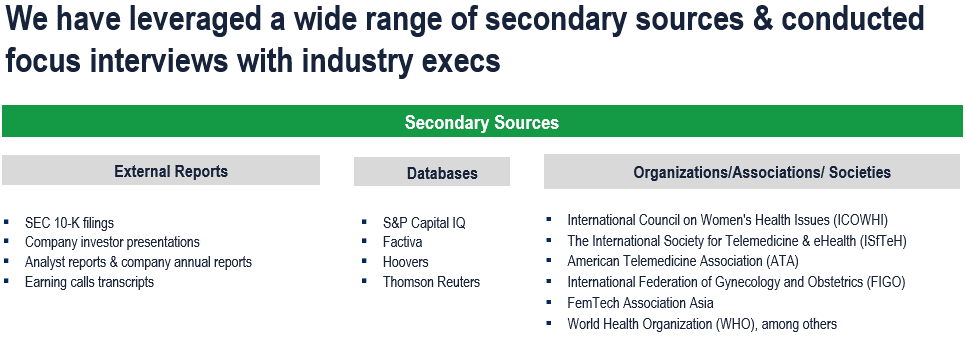
Primary Research
To validate research findings (market size & forecasts, market segmentation, market dynamics, competitive landscape, key industry trends, etc.), extensive primary interviews were conducted with both supply and demand-side stakeholders.
Supply Side Stakeholders:
- Senior Management Level: CEOs, Presidents, Vice-Presidents, Directors, Chief Technology Officers, Chief Commercial Officers
- Mid-Management Level: Product Managers, Sales Managers, Brand Managers, R&D Managers, Business Development Managers, Consultants
Demand Side Stakeholders:
- Stakeholders from Healthcare Providers & Institutions; Employers; Healthcare Payers; and Others
Breakdown of Primary Interviews

Market Size Estimation
Both ‘Top-Down & Bottom-Up Approaches’ were used to derive market size estimates and forecasts
Data Triangulation
Research findings derived through secondary sources & internal analysis was validated with Primary Interviews, Internal Knowledge Repository and Company’s Sales Data

